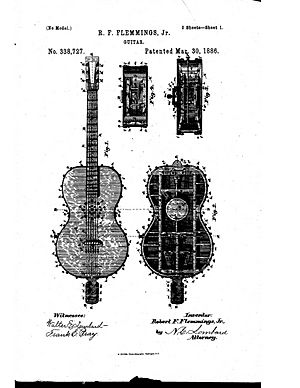Robert F. Flemming Jr. facts for kids
Quick facts for kids
Robert F. Flemming Jr.
|
|
|---|---|
| Born | July , 1839 Baltimore, Maryland, U.S.
|
| Died | February 23, 1919 (aged 79) Melrose, Massachusetts, U.S.
|
| Occupation | Guitar manufacturer, inventor, music teacher |
| Known for | Invention of guitar-like instrument "Euphonica", spotting the H.L. Hunley |
| Spouse(s) | Eleanora Flemming |
| Military career | |
| Other name(s) | Fleming, Flemmings |
| Buried |
Wyoming Cemetery, Melrose, Massachusetts
|
| Allegiance | Union |
| Years of service | 1863–1865 |
| Rank | Landsman |
| Unit | 25th Infantry Regiment Massachusetts |
Robert Francis Flemming Jr. (born July 1839 – died February 23, 1919) was an American inventor. He was also a sailor for the Union during the American Civil War. He is famous for being the first person on the ship USS Housatonic to see the H.L. Hunley submarine. This happened right before the Hunley sank the Housatonic. This event was a big deal because it was the first time a submarine ever sank an enemy ship in a battle.
Contents
Biography
Early Life and Family
Robert F. Flemming Jr. was born in July 1839 in Baltimore, Maryland. He was born a free African-American. His father, Robert F. Flemming Sr., was a baker. His mother was Mary Jane (Holland) Flemming. Robert was their oldest child.
By 1850, his family had moved to Cambridge, Massachusetts. Robert, who was 12 years old, had four younger brothers and sisters. His father passed away soon after. His mother then opened a boarding house to support the family. Robert and his two older siblings started working to help out.
Serving in the Civil War
When the Civil War began, Robert Flemming was working in New York City. He was a marble cutter. On May 14, 1863, he joined the United States Navy. He was given the rank of Landsman. This rank is similar to a "seaman recruit" today.
His first assignment was on the ship USS Wyoming (1859) in June 1863. He was on board when the Wyoming fought against the Japanese Empire's navy. This battle was called the Naval Battle of Shimonoseki. It happened on July 16 of that year.
The Attack on USS Housatonic
In October 1863, Flemming moved to another ship, the USS Housatonic (1861). The Housatonic was sent to help block Southern seaports. This was part of the South Atlantic Blockading Squadron.
On the evening of February 17, 1864, Flemming was on watch duty. He saw something strange in the water. It was about 400 feet away from the front of the ship. He told the officer in charge, but the officer thought it was just a log. Flemming thought it looked like a "queer-looking log."
He looked closer and realized the "log" was not floating with the water. Instead, it was moving very fast towards the Housatonic. Flemming quickly yelled that a "torpedo" was coming! He warned the crew, and they tried to get the Housatonic moving. But it was too late. There was a huge explosion. Within five minutes, the Housatonic sank in 25 feet of water. Five crew members died.
The crew quickly climbed the ship's ropes or got into lifeboats. Even after the ship sank, its masts and ropes were still above the water. Flemming and others held on for about 45 minutes until help arrived.
The Housatonic was sunk by a secret weapon from the Confederate Navy. It was a submarine called the H. L. Hunley. Lieutenant George E. Dixon commanded the Hunley with a crew of seven volunteers. This made the Hunley the first submarine to sink a warship in battle.
From his spot in the rigging, Flemming saw a blue light. It was to the right side of the Housatonic. People later thought this was a signal from the Hunley crew. They might have planned for friendly forces to light bonfires to guide them home. However, the Hunley never returned. Its disappearance became one of the great mysteries of the Civil War.
Invention and Music Career
Flemming finished his time in the navy after June 1865. His last ship was the gunboat USS E. B. Hale. He then went back to Massachusetts. He lived and worked in Cambridge, Massachusetts, and Boston, Massachusetts. There, he started his own business. He became a guitar maker and a music teacher.
Flemming invented a special guitar he named the "Euphonica." He believed his guitar would make a louder and richer sound than regular guitars. The U.S. Patent Office gave him a patent (number 338,727) on March 30, 1886. He also received a Canadian patent (number 26,398) on April 5, 1887. Flemming then opened his own shop in Boston. He built and showed off his musical instruments there.
After 1900, Robert Flemming retired to his home in Melrose, Massachusetts. He continued to give music lessons and perform at different events. In 1907, he wrote a song called "National Funeral Hymn." He dedicated it to the Grand Army of the Republic, a group for Civil War veterans.
Robert Flemming was a member of the Grand Army of the Republic Post no. 30 in Cambridge, Massachusetts. He passed away in February 1919. He is buried in Wyoming Cemetery in Melrose.


